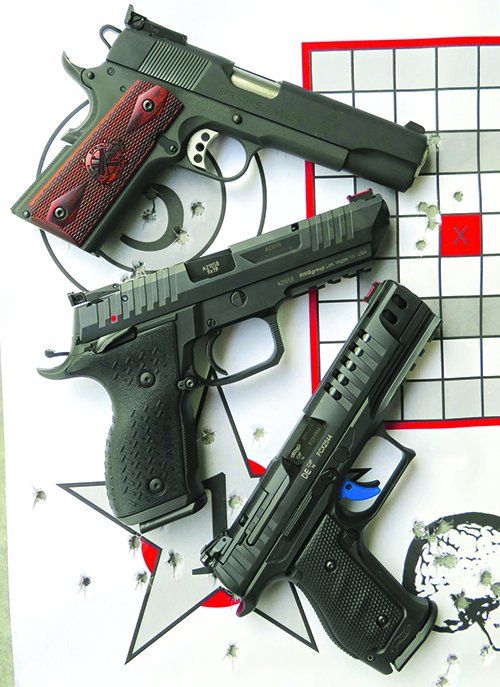The 9mm Luger reigns supreme in action shooting competition pistols because the cartridge is easy to control, inexpensive to train with, and accurate enough for cardboard and steel. It is also used in bullseye competition, though the 45 ACP is the most popular in those style matches. Production divisions in a variety of shooting disciplines are very popular due the fact the pistols are, for all intents and purposes, stock and out of the box. This allows shooters to participate in a shooting sport without having to purchase a custom gun or buy a stock gun and have it tweaked by a gunsmith.
We took a look at three distinctly different competition-ready 9mm pistols.
- The Springfield Armory Range Officer is a 1911-style platform with a single-action trigger.
- The Walther Q5 Match SF (Steel Frame) uses a fully-cocked striker-fire-action trigger.
- And the Arex Rex Alpha uses a double-action to single-action trigger.
These pistols all came in hard plastic cases with die-cut holes in the interior foam for pistol, magazines, and accessories. All came with extra magazines, and — to a certain degree — also have features that make them competition-ready, such as a crisp trigger, big, bold target sights, and extended controls. They are also heavier than the typical polymer-frame concealed-carry or service-size sidearms. All used metal frames, which for Walther is a departure from its recent history of introducing only polymer-framed pistols. Weight is an asset in competitive shooting because it helps reduce felt recoil.
All the pistols also use a short-recoil system with tilting barrel mechanism, the same as nearly every other modern 9mm pistol. While they have similar features and mechanisms, they have distinctly different triggers. The Walther uses a fully cocked striker, which makes the trigger feel crisp. In comparison, a Glock uses a partially cocked striker, so the trigger feel is different. The Arex uses a traditional DA/SA trigger like a SIG P226, CZ75, or Beretta 92FS. The Springfield uses a single-action trigger like all traditional 1911-style pistols. We thought these pistols would offer a good head-to-head comparison, even though the triggers are apples and oranges.
How We Tested
Since these are game guns, we assembled an assortment of training/target ammo in a variety of bullet weights. We wanted to look at how well low-cost ammo — factory new and remanufactured — would run through these pistols since many competitors try to save on ammo costs by reloading or buying remanufactured ammo. Our 115-grain FMJ options were Federal American Eagle and Defender Ammunition. Defender is veteran owned and located in North Carolina. It produces new and remanufactured ammo. They also have a Brass Exchange program where you can send in your sorted, used brass for online store credit. Different calibers have different exchanges rates — 9mm is $1.50 per pound — so we scrounged up a bunch of empties, followed the online instructions (defenderammunition.com/pages/brass-exchange), and had some of Defender’s 115-grain RN ammo sent to us. It was an easy process and, as we found out, the ammo is good and consistent. We also ran Armscor 124-grain FMJs and Atlanta Arms 147-grain FMJs. We felt the speed of these loads in all three pistols. The 115-grain loads gave a snappy recoil due to higher muzzle velocities that ranged from 1150 to 1202 fps. The Atlanta Arms 147-grain ammo was slower, with a muzzle velocity range of 870 to 881 fps. This load was softer shooting. The Armscor 124-grain was snappy, too, with a muzzle-velocity range of 1063 to 1094 fps.
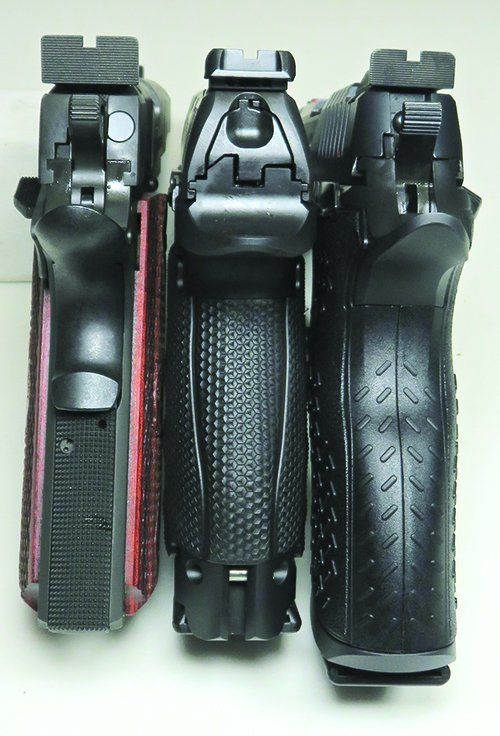
We tested for accuracy using our range bag as a rest at 15 yards using our standby 2-inch black-square target for both the accuracy and speed testing. For the speed test, Bill Drills were performed at 7 yards using six rounds loaded in each of the magazines. We started from the low-ready position and found we could shoot very fast and accurately with these pistols. That’s a good thing, since these pistols were intended for fast, accurate shooting.
Besides the different features and triggers of these pistols, what we really noticed was the difference in muzzle flip between the three pistols. Muzzle flip is a function of the height of center axis of the bore above the shooter’s grip. The higher the bore center axis, the more flip. Bullet weight and velocity also factor into the equation. If you shoot a 1911 chambered in 45 ACP, you know the feeling. With 9mm-chambered 1911s, the flip is less but still noticeable, especially when compared to the other pistols in this match up test. The SA had that 1911 muzzle flip, which is very manageable, but the flip of the Arex was much less due the design of the grip and even less in the Walther. For sheer ability to get back on target fast with minimal muzzle flip, the Walther was the clear winner with the Arex close behind. Both offered minimal flip, which resulted in excellent control. The SA performed as expected from a 1911 platform. At the very least these are all fun pistols to shoot. They aren’t inexpensive, however. Here’s what else we discovered.
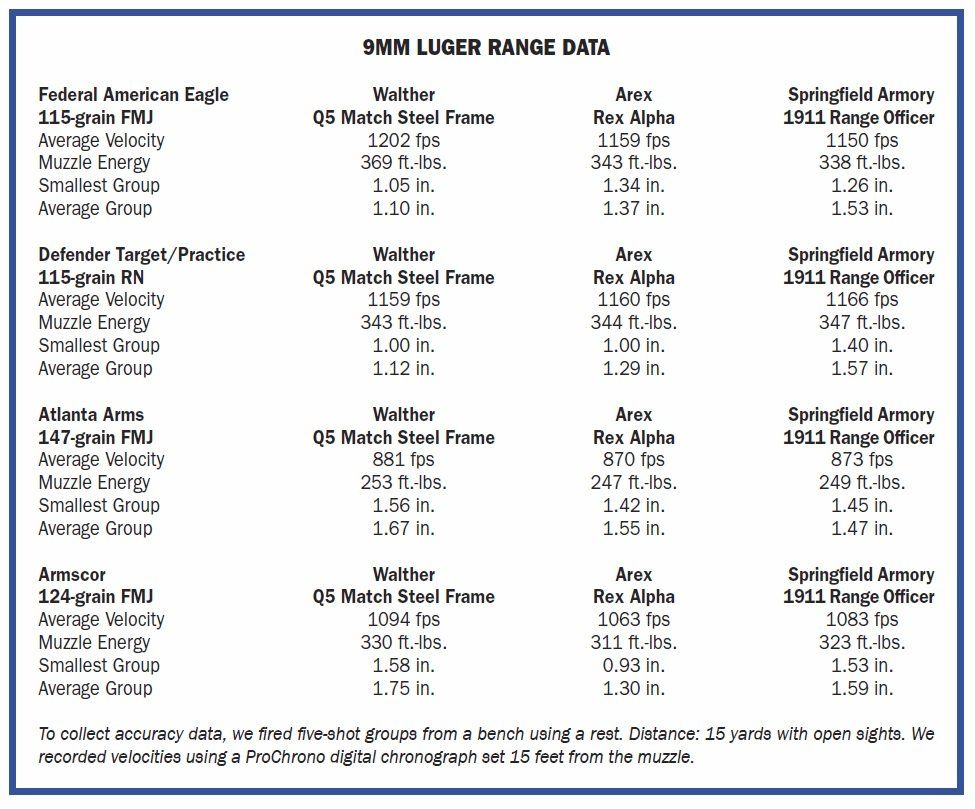
Springfield Armory 1911 Range Officer PI9129LP 9mm Luger, $744
GUN TESTS GRADE: A-
This Range Officer showed the idiosyncrasies of the 1911 platform as well as renowned traits, such as a nice trigger and good accuracy. In our opinion, this would be a good, inexpensive option for certain shooting competitions.
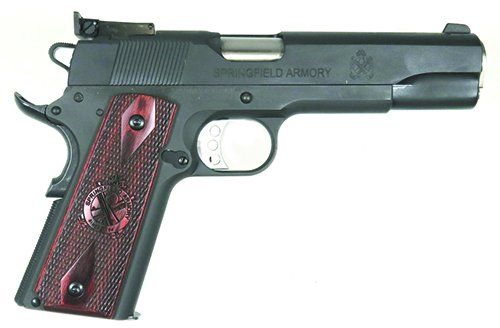
Action |
Single action, locked breech, short recoil |
Overall Length |
8.6 in. |
Overall Height |
5.5 in. |
Maximum Width |
1.5 in. |
Weight Unloaded |
41.0 oz. |
Weight Loaded |
45.0 oz. |
Barrel |
5.0 in. |
Capacity |
9+1 |
Slide |
Parkerized, steel |
Slide Retraction Effort |
13.0 lbs. |
Frame |
Parkerized, steel |
Frame Front Strap Height |
2.5 in. |
Frame Back Strap Height |
3.1 in. |
Grips |
Checkered cocobolo |
Grip Thickness (max) |
1.3 in. |
Grip Circumference (max) |
5.5 in. |
Front Sight |
Post |
Rear Sight |
Adjustable |
Trigger Pull Weight |
6.0 lbs. |
Trigger Span |
2.8 in. |
Magazines |
3; stainless steel |
Safety |
Thumb, beavertail grip |
Warranty |
Lifetime |
Made In |
Brazil/USA |
Website |
Springfield-Armory.com |
All the prices listed are recent prices from BudsGunShop.com. Inside the Range Officer (RO) plastic case were two stainless-steel 9-round magazines, a cleaning brush, polymer holster and polymer double-magazine holder. All you need to compete is a sturdy belt. The RO is a traditionally styled GI-style 1911 with a domed slide fitted with large target sights. The black front post and black adjustable rear sights are good even when shooting at a black target. The rear sight is flush with the end of the slide and serrated to cut glare.
Our sample had an excellent Parkerized finish on the steel receiver and slide. It features a stainless match-grade barrel, traditional GI-style bushing, and a long aluminum match-grade trigger. The trigger broke at a crisp 6 pounds. There is a little take up, about 0.125 inch, then a crisp release. Trigger reset was short. It is equipped with an extended thumb safety for right-handed shooters. The slide stop was also extended, so transitioning from a locked-back slide to a freshly loaded pistol was smooth — except for a few initial failures that we will get into. Fine angled serrations are located at the rear of the slide only, similar to a GI 1911A1. It also featured a skeletonized hammer.
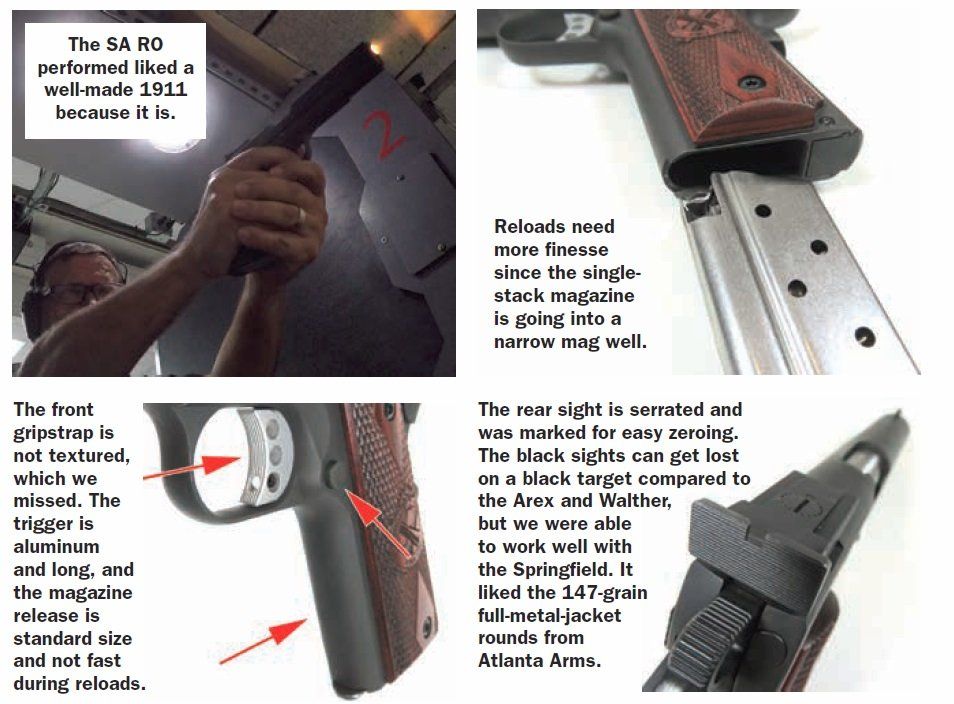
The mainspring housing is checkered, and the front grip strap is smooth. We wanted a bit more texture on the front strap. The grip safety had a good beavertail, and the speed bump was large enough so even a sloppy grip allows the shooter to fire the pistol. The grips are checkered cocobolo in double-diamond style and SA’s crossed-cannons logo. We thought grip panels were serviceable and looked good. You may want to swap them out with some better-textured G10 grips, but these grips will get you started.
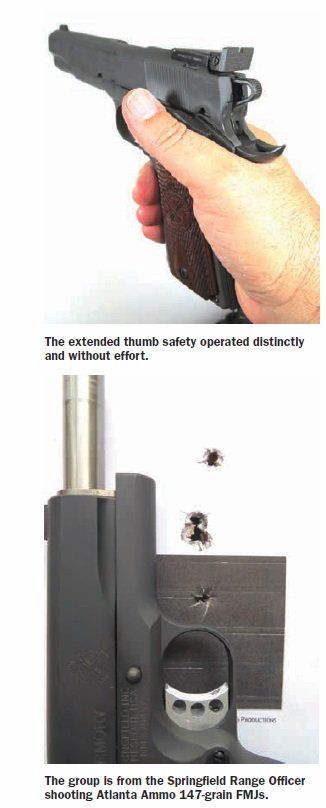
We had high hopes for the RO, then came the range test. We loaded up with some orphan rounds to get the 1911 running. We did not collect data on this ammo since we did not have enough on hand. From the get-go, we experienced numerous failures to go into battery, and the slide would not lock back on the last round fired. This didn’t faze us since new 1911s require a bit of breaking in, but we did wonder if the final score would be an F. The RO being a new 1911, we field-stripped it and lubed it. Then the RO came to life.
It’s easy to like the RO since the trigger and sights don’t make you work too hard. The black sights on black target were a bit lost on our black-square target compared to the Arex and Walther, but we were able to work well with the RO. The weight of this pistol, 41 ounces, helps to stifle some flip, but we did notice the flip. It liked the 147-grain FMJs from Atlanta Arms, giving us the best overall accuracy. Our best 5-shot group measured 1.26 inches with Federal American Eagle 115-grain FMJ bullets. Sweet.
Making fast magazine reloads with a 1911 takes training. There is a small bevel on the magazine well, but the top of the single-stack magazine is nearly the same size as the magazine-well hole, so it takes some finesse to load fast. Our suggestion is to perform reloads smoothly with minimal movement, and speed will come. Those familiar with a 1911 had no problems, but newbies to the 1911 system lagged during reloads.
Our Team Said: We did notice muzzle flip and initially experienced the idiosyncrasies of the 1911 design in the RO. It also holds fewer rounds, and that may be a stopper depending on the category you plan to compete in. For IDPA, we think this is a good option. We liked the trigger. The RO did show its design age and required break in, but after that it ran hard. You will need to keep the RO well lubed for it to perform at its best. We like 1911s, especially those like the SA RO, though you might want to keep your options open depending on the type of competition you intend to enter. Plus there are plenty of 1911 aftermarket parts to tweak the RO to your liking. At the very least, this is a fun-to-shoot pistol.
Arex Rex Alpha REXALPHA9-01 9mm Luger, $999
GUN TESTS GRADE: F
Initially, the Rex Alpha performed well — good grip shape, accurate, and minimal muzzle flip. In extended testing, the slide sheared off the hammer. After extensive conversations with FIME, we received a replacement part and have begun testing again. Until the retest is complete, we give the gun an F.
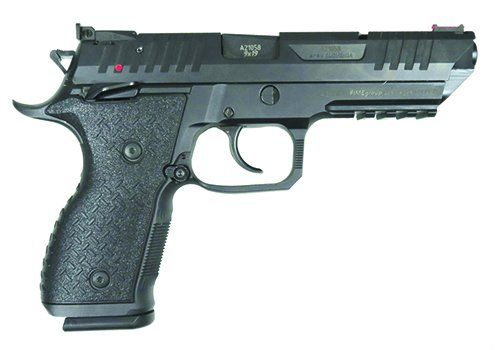
Frame |
Black, steel |
Frame Front Strap Height |
2.4 in. |
Frame Back Strap Height |
3.3 in. |
Grip |
Textured polymer |
Grip Thickness (max) |
1.33 in. |
Grip Circumference (max) |
5.87 in. |
Front Sight |
Fiber optic |
Rear Sight |
Adjustable |
Trigger Pull Weight Double Action |
12.0 lbs. (standard, blue spring) |
Trigger Pull Weight Single Action |
2.98 lbs. |
Trigger Span Double Action |
3.0 in. |
Trigger Span Single Action |
2.54 in. |
Magazines |
3; steel |
Manual Safety |
Thumb |
Warranty |
Limited 1 year |
Made In |
Slovenia |
Website |
FIMEgroup.com |
The Rex Alpha has an angular look. It comes with three steel 17-round magazines and two additional hammer springs. This pistol is similar to the Arex Rex Zero 1 Standard, which we graded B back in 2018. What the Rex Alpha lacks is the decocking mechanism of the Rex Zero 1. So, in actual use, the Rex Alpha can be cocked and locked like a 1911 platform. Check the rules of the sport you want to compete in because some disciplines may require you to start off in double-action mode.
The Rex Alpha features a steel frame and slide and a 5-inch barrel. The dust cover is sharply angled and sports a Picatinny rail. Coarse slide serrations are located on the rear and front of the slide and offer a good grip. Relief cuts are made in the top of the slide to lighten it. The front sight is a red-fiber-optic unit dovetailed into the slide. The rear sight is adjustable for windage and elevation and sits flush with the rear of the slide. The flat surfaces of the sights that face the shooter are serrated to reduce glare.
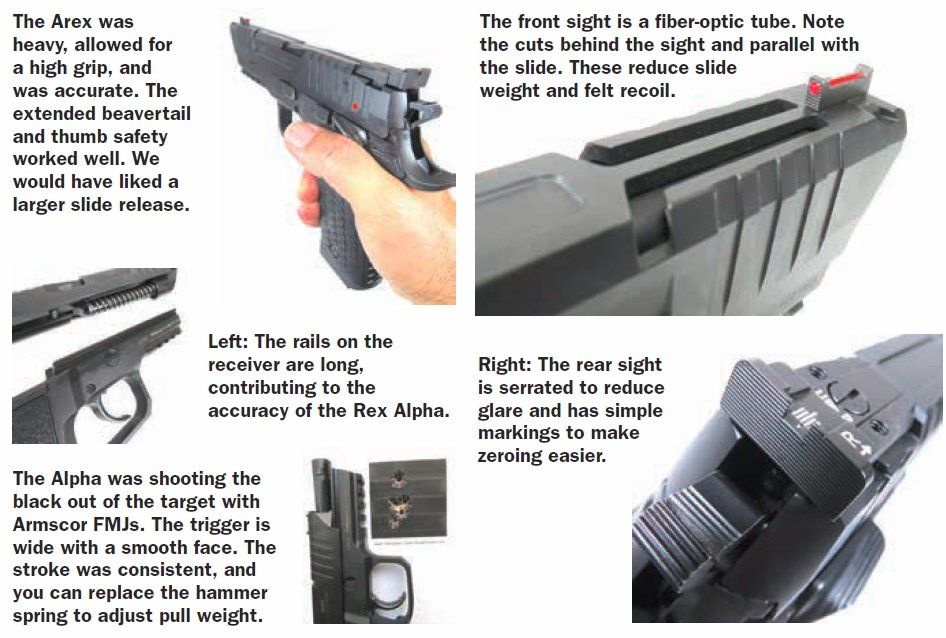
The Rex Alpha is designed for competition shooting, which becomes obvious with features like an extended, ambidextrous magazine release button and ambidextrous safety levers. Flip the safety up, and the trigger is deactivated but the slide can be retracted. A nice feature. Flip it down and the pistol can be fired. The levers are smaller than an extended 1911 safety lever but that did not hinder performance. All the controls worked flawlessly. The large magazine release made it easy and fast to dump the empty magazine. The trigger is wide and smooth and offers a smooth consistent pull and clean break at 13 pounds, which in our opinion is too heavy for a competition pistol. In single-action mode, the trigger broke at a clean 3.5 pounds. You can modify the DA trigger-pull-weight with additional springs included with the gun. The grey-colored spring is light weight, and the yellow spring is heavy. The standard weight, a blue-colored spring, came installed in the pistol. The recoil spring guide rod is metal, and the slide fits onto the receiver on long rails. These two features help ensure an accurate pistol.
The grip is very different compared to the Rex Zero 1. The Alpha’s grip allows the user to get a higher hand hold on the pistol to reduce the distance between the center axis of the bore and the user’s hand. It also has an extended beavertail grip, so there were no gripes from our ham-fisted shooters. There is an undercut behind the trigger guard that also allows for the higher grip. The grip has a nice full feel without being chunky and has a coarse texture. The front grip strap is serrated.
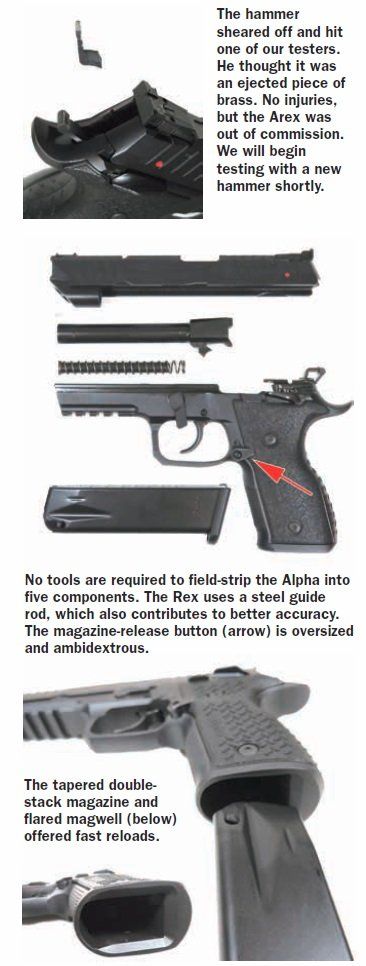
Going hot with the Alpha, we loaded up with orphan rounds to warm up and get a feel for the pistol. We were impressed with the pistol’s accuracy, our ability to manage flip and recoil, and the speed with which we could shoot. The Rex Alpha chewed through all the ammo we fed it. There was noticeably less muzzle flip with the Rex Alpha compared to the Range Officer. With Armscor 124-grain FMJ ammo, we fired our smallest five-shot group, 0.93 inch. Shooting for speed and incorporating fast reloads, we found the extended magazine floorplate pads help to more rapidly seat fresh magazines with the palm of our hand. The magazine well is beveled, and the tapered design of the double-stack magazine allows a user to more easily and quickly insert the magazine into the magazine well.
The slide release is a bit small but was easy to operate smoothly. Going from slide lock back to fresh magazine was effortless. We liked the oversized magazine-release button and it was ambidextrous. Still, for a competition pistol, we would have liked the slide stop to be a bit larger. Not a disqualification by any means. That would come later.
The sights were good, and the weight of the pistol helped keep us on target. At 39 ounces unloaded, the Rex Alpha was the lightweight among our three test pistols. When loaded with 17 rounds, weight increased to 46.14 ounces.
We did not expect to eat Slovenian steel, but during the tail end of speed testing, the slide sheared off the top of the hammer, sending a piece of metal into the face of one of our testers, who thought it was empty brass. No injuries, but plenty of disappointment.
Our Team Said: The Rex Alpha is an excellent pistol for those who like a DA/SA trigger. Since the Rex can be cocked and locked like a 1911, you don’t necessarily need to start with an initial DA trigger pull. We liked the grip. Not sure why the decocker was not included on this pistol. We suspect the grip design of the Alpha does not allow for the decocking mechanism like in Rex Zero 1. There are aftermarket parts for the Rex Alpha, so you can customize the pistol to your liking. Since we had a failure with the pistol that would stop us from shooting it, we graded it an F.
After the hammer failed, we went to the FIME website and sent a email via the website. We did not identify ourselves as Gun Tests because we wanted to see how the company handled a typical customer issue. Ten days later we received an email from FIME Customer Service requesting the model, serial number, date of purchase, our name, address, and phone number. They said they would send out a replacement hammer. Five days elapsed and we did not receive a confirmation email that the hammer was shipped, so we called Customer Service. Customer Service confirmed that the hammer had been shipped. While we were on the phone we asked how the hammer could have failed and what was the frequency of these failures. The customer service rep was very helpful and apologetic. He said there could have been an issue with the metal composition during the molding process. The hammer is an MIM part. He also said in the last two years, three hammers have failed; two on the Rex Zero pistols and this one on the Alpha Rex. Very rare. They offered to do the repair themselves in lieu of sending us the hammer. We are waiting on delivery of the hammer and will reevaluate the Rex Alpha at that point and adjust the grade, if needed.
Walther Q5 Match Steel Frame 2830001 9mm Luger, $1277
GUN TESTS GRADE: A-
We liked the grip, which made the Q5 a soft shooter. The ability to mount a red-dot sight makes it versatile. The cost is steep, but this pistol excels in fast action shooting.
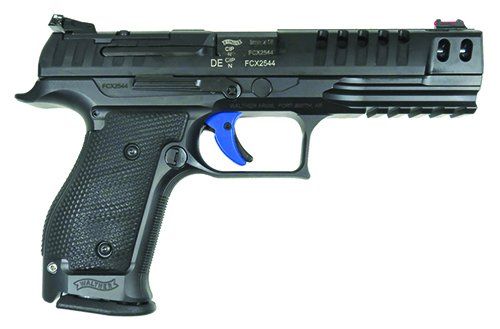
Action |
Locked breech, short recoil, striker-fire |
Overall Length |
8.7 in. |
Overall Height |
5.4 in. |
Maximum Width |
1.3 in. |
Weight Unloaded |
41.6 oz. |
Weight Loaded |
47.9 oz. |
Barrel Length |
5.0 in. |
Capacity |
15+1 (double stack) |
Slide |
Black, steel |
Slide Retraction Effort |
16.0 lbs. |
Frame |
Black, steel |
Frame Front Strap Height |
2.1 in. |
Frame Back Strap Height |
3.1 in. |
Grip |
Checkered polymer |
Grip Thickness (max) |
1.38 in. |
Grip Circumference (max) |
5.75 in. |
Front Sight |
Fiber optic |
Rear Sight |
Adjustable, optic mount |
Trigger Pull Weight |
5.5 lbs. |
Trigger Span |
2.77 in. |
Magazines |
3; steel |
Manual Safety |
Trigger |
Warranty |
Limited lifetime |
Made In |
Germany |
Website |
WaltherArms.com |
If the Rex Alpha is a rung up from the RO, then the Q5 is multiple rungs up from the Rex Alpha. There is no mistaking that Walther designed this pistol for competition shooting. In fact the Q5 is USPSA approved for Production and Carry Optics, and IDPA approved for Stock Service Pistol and Carry Optics. This is a unique looking pistol with multiple weight-relief cuts in the slide and a blue trigger.
Based on the polymer-frame PPQ M2, the Q5 design incorporates many of the PPQ M2’s features, but does it better, especially with the steel frame. When we tested a PPQ M2 Navy in 2015, we gave it a B. We think Walther listened to shooters, and the Q5 is the result.
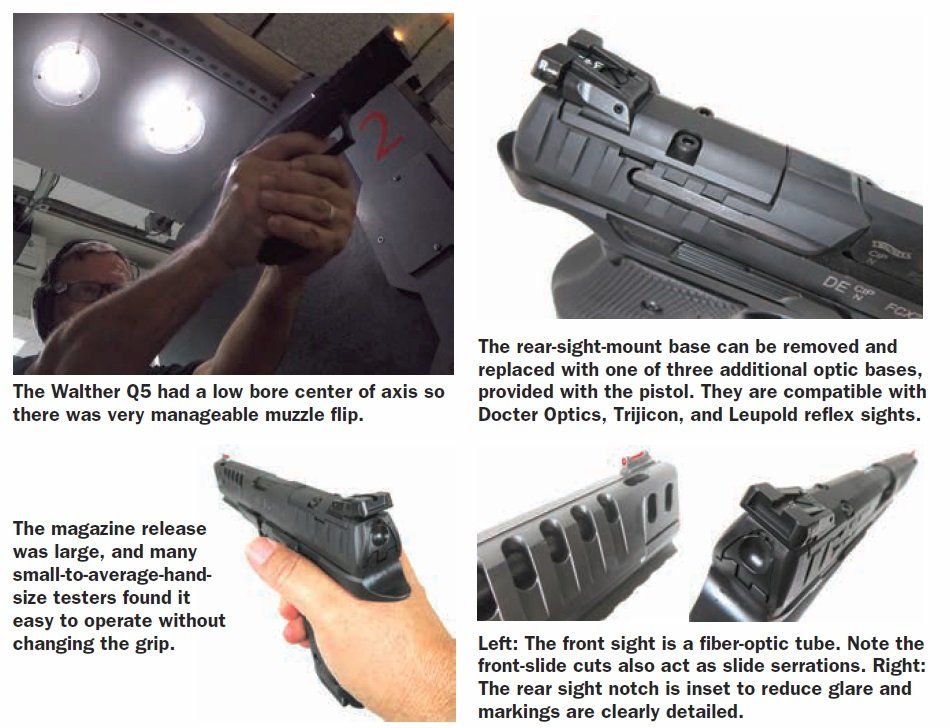
In the hard case are three 15-round steel magazines with polymer floor plates, three reflex-sight mounting plates, and a magazine loader. All fit into foam cutouts.
As mentioned, this is a steel-frame pistol with a full-length Picatinny rail, large trigger guard, beveled magazine well, and extended beavertail. In hand, the pistol feels much different than the PPQ polymer-frame grip. There is also the weight of the Q5 SF, which is 42 ounces compared to the polymer version, the Q5 Match, at 29 ounces. The Q5’s grip is textured and rubbery with slight palm swells. It does an excellent job of filling your hand without feeling chunky. The grip length was slightly smaller than the other pistols. The front grip strap is finely checkered. The beavertail allows the shooter to get a high grip on the pistol. The pistol has a nice balance and is not muzzle heavy. You can add a magazine funnel ($89.50; shop.waltherarms.com), which essentially converts the Q5 Match SF to a Q5 Match Pro SF model sans the extended magazines. Mag extensions are also available ($49.90; shop.waltherarms.com).
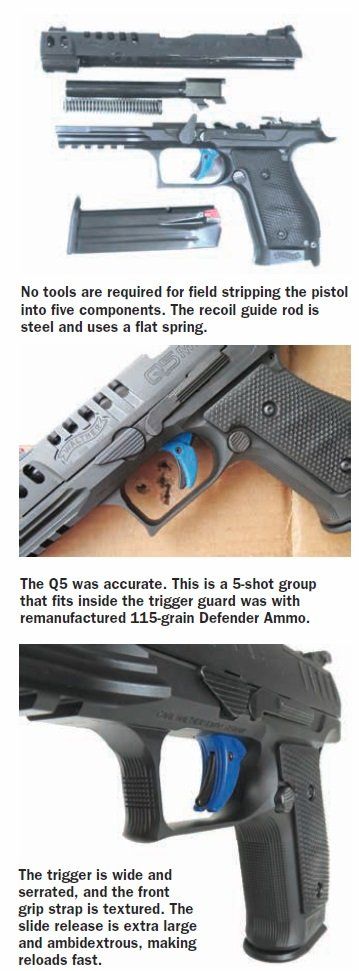
The slide is aggressively machined to reduce weight. The cuts act like large slide serrations at the muzzle, and there are coarse serrations at the rear. Walther also mills long serrations on the top side of the slide, which gives the Q5 a traditional Walther look. It uses a steel guide rod, which helps with accuracy. The long extractor acts as a loaded-chamber indicator.
The front sight is a red-fiber-optic post, and the rear is fully adjustable. Both can be replaced with other aftermarket sights if so desired. We liked these sights. You can also mount a reflex red-dot optic to the Q5 with the three optic plates that are provided.
The controls are well laid out. The slide release is extended and ambidextrous. The magazine release is reversible, and the button is the same size as the Q5 Match polymer frame, but there is not a ridge under it to hamper use. The Q5 SF magazine button is easier to use.
Going hot, the Q5 was a very soft shooter and had minimal muzzle flip. It was easy to stay on top of this pistol. Initially, we had issues with the slide not locking back on the last shot fired. That resolved itself after a few magazines. We fired a best five-shot group with 115-grain Defender ammo that measured 1.00 inches. Federal American Eagle was close behind, with a best group that measured 1.05 inches. Clearly, the Q5 had a preference for 115-grain ammo. Moving to the speed portion of the test, we liked how the Q5 handled. Transitioning from slide lock to magazine reload was smooth, thanks to the extended magazine button and extended slide release. The trigger was crisp and helped us achieve the small groups. Walther’s Quick Defense trigger is an excellent striker-fire trigger.
Our Team Said: The Q5 SF is very pricey, but the pistol performs, and it costs less than a custom gun. You could get by with a less costly option, but the Q5 SF sets you up to compete in either iron or optic classes. There are plenty of aftermarket parts for the Q5 in case you want to tweak it. We would choose this pistol for ourselves if cost was not an option.
Special thanks to Eastern Outfitters (easternoutfitter.com) of Hampstead, NC,for their assistance.
Written and photographed by Robert Sadowski, using evaluations from Gun Teststeam testers.



























